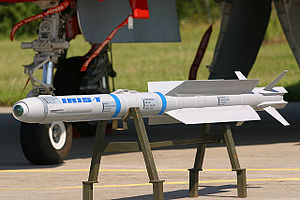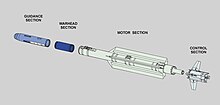IRIS-T
This article needs additional citations for verification. (June 2014) |
| IRIS-T | |
|---|---|
 Mockup of the IRIS-T | |
| Type | Short-range air-to-air missile |
| Place of origin | Italy, Germany, Sweden, Greece, Norway, Canada |
| Service history | |
| In service | December 2005 |
| Used by | See operators |
| Production history | |
| Manufacturer | Diehl BGT Defence, , Litton Italian, [1] |
| Unit cost | €380,000[2] (~US$430,000) |
| Specifications | |
| Mass | 87.4 kg (193 lb) |
| Length | 2.94 m (9.6 ft)[3] |
| Diameter | 127 mm (5.0 in) |
| Warhead | HE/Fragmentation |
Detonation mechanism | Impact and active radar proximity fuse |
| Engine | Solid-fuel rocket |
| Wingspan | 447 mm (17.6 in) |
Operational range | 25 km (16 mi)[3] |
| Flight altitude | Sea level to 20,000 m (66,000 ft) |
| Maximum speed | Mach 3 |
Guidance system | Infrared homing |
Launch platform | Typhoon, Tornado, F-4, F-16, NASAMS, Gripen, F/A-18. |
The IRIS-T (Infra Red Imaging System Tail/Thrust Vector-Controlled) is a German-led program to develop a short-range infrared homing air-to-air missile to replace the AIM-9 Sidewinder found in some NATO member countries. Any aircraft capable of firing the Sidewinder is also capable of launching the IRIS-T.[4]
History[]


In the 1980s, NATO countries signed a Memorandum of Agreement that the United States would develop a medium-range air-to-air missile to replace the AIM-7 Sparrow, while the UK and Germany would develop a short-range air-to-air missile to replace the AIM-9 Sidewinder. The US design developed as the AIM-120 AMRAAM, while the UK-German design developed as the AIM-132 ASRAAM.[citation needed]
The roots of the ASRAAM dated back to 1968 when development began on the Hawker Siddeley SRAAM ('Taildog'), but this project ended in 1974 with no production orders. This work was dusted off for the UK/German effort, with the Germans providing a new seeker, and the UK providing most of the remaining components. In the intervening time, the need for high maneuverability was downgraded in favor of greater range.[citation needed]
After German reunification in 1990, Germany found itself with large stockpiles of the Soviet Vympel R-73 missiles (NATO reporting name: AA-11 Archer) carried by the MiG-29 Fulcrum and concluded that the AA-11's capabilities had been noticeably underestimated.[5] In particular, it was found to be both far more maneuverable, and far more capable in terms of seeker acquisition and tracking than the latest AIM-9 Sidewinder.[6] In 1990 Germany withdrew from the ASRAAM project, while the UK resolved to find another seeker and develop ASRAAM according to the original requirements.[7]
In late 1990, the US partnership expressed similar concerns and embarked on an upgrade to the existing Sidewinder design to provide increased maneuverability and IRCCM (infrared counter counter measures) performance, i.e. measures to counter infrared countermeasures (IRCM). This program was designated AIM-9X.[8]
Missile characteristics[]
In comparison to the AIM-9L Sidewinder, the IRIS-T has higher ECM-resistance and flare suppression.[9] Improvements in target discrimination not only allows for 5 to 8 times longer head-on firing range than the AIM-9L. It can also engage targets behind the launching aircraft, the latter made possible by the extreme close-in agility allowing turns of 60 g at a rate of 60°/s via thrust vectoring and LOAL capability.[10][3]
The Royal Norwegian Air Force (RNoAF) has tested a new air-to-surface capability developed by Diehl BGT Defence for the IRIS-T. A proof of concept test firing to acquire, track, and engage a target representing a small fast attack boat was conducted in Norway in September 2016, where the IRIS-T missile was launched from an RNoAF F-16AM multirole aircraft. For the air-to-surface role, the missile retains the same standard IRIS-T AAM hardware configuration, including the HE warhead and IIR guidance package, with only an updated software insertion required to deliver the additional ground attack capability.[11] This basic air-to-ground capability provides the ability to acquire, track and engage individual ground targets like boats/ships, small buildings and vehicles.[12]
In addition, the IRIS-T has the unique ability, in comparison to other similar missiles such as the AIM-9X, to target and shoot down other air-to-air and surface-to-air missiles thus offering 360° defence capability.[13][3] In fact, a surface launched variant of the IRIS-T the IRIS-T SL actually has even further enhanced capabilities capable of destroying aircraft, helicopters, cruise missiles, air-to-surface missiles, anti-ship missiles, anti-radar rockets and large-calibre rockets. It also has high probability of a killing shot against UAVs and other small maneuvering threats at very-short and medium-range distances.[14]
Development partners[]
In 1995, Germany announced the IRIS-T development program, in collaboration with Greece, Italy, Norway, Sweden and Canada. Canada later dropped out, while in 2003 Spain joined as a partner for procurement.[15] The German Air Force took first delivery of the missile on 5 December 2005.[16]
Workshare arrangements for IRIS-T development are:[1]
- Germany 46%
- Italy 19%
- Sweden 18%
- Greece 13%
- 4% split between Canada and Norway.
Variants[]
IDAS[]
The IDAS variant is a navalized version of the missile, is also being developed for the new Type 212A submarine of the German Navy. IDAS is supposed to engage air threats, small or medium surface vessels or near land targets.
IRIS-T SL[]
Within the MEADS program, the German Air Force plans to integrate a surface-launched (SL) radar-guided version of the missile, called IRIS-T SL. It has a pointed nose, unlike the regular IRIS-T.[17] The IRIS-T SL qualification tests were completed during January 2015 at the Denel Overberg Test Range in South Africa.[18] It is built in two variants IRIS-T SLS (short-range)[19] and IRIS-T SLM (medium-range).[20]

IRIS-T SL missile

IRIS-T SL launch system
SAM Version[]
The Swedish Army is fielding a ground launched version of the IRIS-T, designated RBS 98, to replace the RBS 70 missile system. Four missiles are carried on a special version of a Bv 410 tracked, armored vehicle.[21]
The Norwegian Army has decided to acquire a "Mobile Ground Based Air Defence System" in a direct acquisition with Kongsberg Defence & Aerospace. The deliveries are planned for 2018 to 2021 and the system will reuse NASAMS command and control and its network solutions, to create a "highly mobile, short-range air defence system".[22] The project includes six modified M113 vehicles carrying IRIS-T-missiles.[23]
A version with a Lockheed Martin command and control station and SAAB Giraffe 4A AESA radar was shown at IDEX 2019 under the name Falcon.[citation needed]
Air-to-ground[]
For the air-to-surface role, the only difference from air-to-air version is an updated software insertion required to deliver the additional ground attack capability. Tested by Royal Norwegian Air Force.[24]
Operators[]

The following operators are listed and defined as of July 2008.
 Austria
Austria- 25[25]
 Germany
Germany- 1,250[25]
 Egypt
Egypt- 7 IRIS-T SLM land-based systems.[26]
 Greece
Greece- 350[25]
 Italy
Italy- 444[citation needed] budget €217m, between 2003 and 2015.[27]
 Norway
Norway- 150[28]
 Saudi Arabia
Saudi Arabia- 1,400[29]
 South Africa
South Africa- 25 missiles delivered. Interim armament for Saab JAS 39 Gripen aircraft until the completion of the A-Darter SRAAM project.[30][31]
 Spain
Spain- 770 Original budget €247m, final cost €291m.[2]
 Sweden
Sweden- 450[25]
 Thailand
Thailand- Ordered, 220 to be delivered.[28] Integrated with Northrop F-5 F-5T Saab Jas 39 Gripen Gripen C/D and F-16 eMLU .[32]
Future operators[]
 Brazil
Brazil- For the new JAS 39 Gripen E/F variants.[33]
 South Korea
South Korea- [34]
See also[]
References[]
Notes[]
Citations[]
- ^ Jump up to: a b "BGT/SAAB/Alenia IRIS-T". Archived from the original on 22 January 2009.
- ^ Jump up to: a b "Evaluación de los Programas Especiales de Armamento (PEAs)" [Special armament programs evaluation] (PDF). Atenea (in Spanish). Madrid: Ministerio de Defensa. September 2011. Archived from the original (PDF) on 24 October 2013. Retrieved 30 September 2012.
- ^ Jump up to: a b c d "Diehl Defence: IRIS-T, the short-distance missile of the latest generation". Diehl.com. Archived from the original on 30 March 2014. Retrieved 11 March 2015.
- ^ "IRIS-T European Short Range Air-to-Air Missile" (PDF). Archived from the original (PDF) on 19 November 2012.
- ^ Menon, KB. "Evolution of the Air-To-Air Missiles: Options for the IAF". Retrieved 11 June 2014.
- ^ "Locking range". Retrieved 11 June 2014.
- ^ Arms and the State: Patterns of Military Production and Trade. Cambridge University Press. 25 August 1995. 253. ISBN 0521558662.
- ^ Tirpak, John. "The Evolution of the Force". Retrieved 11 June 2014.
- ^ "IRIS-T Guided Missile Family, Germany". Retrieved 11 June 2014.
- ^ "IRIS-T Air-to-Air Guided Missile, Germany". Retrieved 11 June 2014.
- ^ "Diehl develops air-to-surface capability for IRIS-T AAM". Archived from the original on 16 December 2016.
- ^ "Diehl Press release: Royal Norwegian Air Force tested IRIS-T in air-to-ground mission". Archived from the original on 16 December 2016.
- ^ "IRIS-T European Short Range Air-to-air Missile" (PDF). Archived from the original (PDF) on 12 June 2013. Retrieved 10 March 2018.
- ^ "IRIS-T SL Surface-to-Air Guided Missile". Archived from the original on 31 October 2014.
- ^ "IRIS-T – the world's highest-performance, short-range, air-to-air guided missile". Archived from the original on 6 March 2016.
- ^ "Germany tees-off with Iris". Archived from the original on 10 September 2017. Retrieved 11 June 2014.
- ^ "IRIS-T Guided Missile Family IRIS-T SL". Archived from the original on 13 January 2013.
- ^ "IRIS-T SL achieves qualification after successful firings at Overberg". defenceWeb. 10 February 2015. Retrieved 11 March 2015.
- ^ "IRIS-T SLS – surface-launched, short-range guided missile". Diehl Defence. Retrieved 9 June 2015.
- ^ "IRIS-T SLM". Deagel. Retrieved 9 June 2015.
- ^ "Nytt robotsystem till Försvarsmakten".
- ^ "Norway acquires Army Mobile Ground Based Air Defence". Kongsberg Defence & Aerospace. 6 February 2017. Retrieved 10 February 2017.
- ^ "For første gang på 14 år kan Hæren selv beskytte seg mot luftangrep". tu.no. 6 February 2017. Retrieved 10 February 2017.
- ^ "Diehl develops air-to-surface capability for IRIS-T AAM". Archived from the original on 16 December 2016.
- ^ Jump up to: a b c d "South Africa Orders IRIS-T Missiles". Defense industry daily. Retrieved 17 June 2014.
- ^ "Federal Government approves arms exports to Gulf States". Rheinische Post. 19 September 2018. Retrieved 19 September 2018.
- ^ "Nota Aggiuntiva allo stato di previsione per la Difesa per l'anno 2012" (PDF) (in Italian). Ministero delle Difesa. April 2012. Retrieved 19 April 2014.
- ^ Jump up to: a b "Diehl Defence: IRIS-T, the short-distance missile of the latest generation". Diehl.com. Archived from the original on 30 March 2014. Retrieved 19 April 2014.
- ^ "Trade Registers". Armstrade.sipri.org. Retrieved 19 April 2014.
- ^ "Sipri: Trade Registers". Portal.sipri.org. Archived from the original on 23 April 2014. Retrieved 11 March 2015.
- ^ "SAAF maintaining IRIS-T". defenceWeb. 23 May 2011. Retrieved 11 March 2015.
- ^ "Thai F-5s to fight on with IRIS-T missiles".
- ^ "Conheça as armas do caça Saab Gripen E/F da FAB". Poder Aéreo (in Portuguese). 15 September 2017.
- ^ "South Korea confirms Meteor, Iris-T integration on KF-X fighter jet".
Bibliography[]
- Bonds, Ray ed. The Modern US War Machine. New York City: Crown Publishers, 1989. ISBN 0-517-68802-6.
External links[]
| Wikimedia Commons has media related to IRIS-T. |
- International air-to-air missiles
- Surface-to-air missiles
- Air-to-surface missiles
- Military equipment introduced in the 2000s




